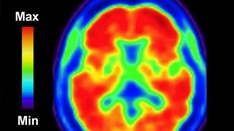A new classification system for biomarkers of Alzheimer's disease that includes measures of amyloid (A), tau (T), and neurodegeneration (N) has been proposed.
The system, described in a paper published online July 1 in Neurology, includes different ways of measuring all three biomarkers (positron emission tomography [PET] scans, cerebrospinal fluid sampling, MRI scans) and gives each biomarker a positive or negative status.
The authors, led by Clifford R. Jack Jr, MD, Mayo Clinic, Rochester, Minnesota, explain that an individual score might appear as A+/T+/N–, which would provide immediate simple information about the patient's risk profile.
Dr Jack told Medscape Medical News that a major impetus for the proposal for this new classification was the recent introduction of tau-PET imaging.
He noted that current classification of patients for research purposes use measures of amyloid and neurodegeneration as biomarkers for Alzheimer's, but there are two different sets of criteria developed by two different groups: the International Working Group and the National Institute on Aging– Alzheimer's Association.
"These two groups apply different terminology to specific biomarker profiles, which is confusing for research, clinical trials, and regulatory systems. Now we can measure tau as well; we need a new classification system, and it would be helpful if we just had one that included all relevant biomarkers. The scheme we are proposing is a step in the direction of harmonizing the two systems we have today with some additions," said Dr Jack.
Applicable for All Dementia Types
The current proposal is for each biomarker to have a simple positive or negative result, depending on a specific threshold, although those thresholds have not yet been defined.
However, Dr Jack suggests that in future there could be a graded system wherein each biomarker is given a score between 0 and 100 depending on levels/severity. In addition, other biomarkers could be added, such as Lewy bodies (responsible for the main underlying dementia of Parkinson's disease) and possibly markers of cerebrovascular disease.
"So it could be applied to all types of dementia. At present, while we have a pretty good idea what levels of these biomarkers are pathological, we don't know if reducing them will lead to improvement and what targets we need to be aiming for. But in future it is likely we will have these things," he said.
Dr Jack explained that the proposed classification system could be used in many different patient populations.
"For those patients who already have dementia, it would tell us which type of dementia they have, while for those who have not yet developed dementia it can give a risk estimate for future dementia and idea of timescales."
In the paper, the authors expand on this with specific examples. They note that an A–/T–/N+ profile would signify non-Alzheimer's dementia, whereas an A+/T–/N+ profile might indicate an individual in the earliest stage of preclinical Alzheimer's disease (accounting for the A+/T– status) who also has non-Alzheimer's pathology, such as hippocampal sclerosis (accounting for the N+ status).
Dr Jack said the biomarkers are regarded primarily as a research tool at present.
"We are not measuring these biomarkers routinely in clinical practice yet, mainly because payers are reluctant to fund the tests in the absence of therapies that may treat or slow the condition. But this will change in the future."
Novel Approach
In an accompanying editorial, Alison D. Murray, MBChB, PhD, University of Aberdeen, United Kingdom, describes the new proposed classification system as "a novel take on how to report biomarkers in cognitive aging and dementia research."
She notes that the proposed system "moves away from esteemed opinion-based guidelines to factual reporting of relevant biomarkers," which, she said, "can only be helpful."
In an interview with Medscape Medical News, Professor Murray explained that various biomarkers associated with Alzheimer's have been recognized but the importance of individual markers is unclear.
"This new classification system is useful as it includes three different biomarkers and different ways of detecting each one.
"At present Alzheimer's is a clinical diagnosis, made by a failure of memory persistent for at least 6 months with no other explanations. Biomarkers can support this. But there is great variability in cognition between individuals, which makes the diagnosis imprecise. Biomarkers can help firm this up. This new system of biomarkers without any clinical information is a new take and a valuable one," she added.
Professor Murray agrees with Dr Jack that measuring these biomarkers is not appropriate for clinical practice at the present time.
"But in future — when we have some treatments available — it will be very important to diagnose Alzheimer's and to identify people at high risk. We will probably have drugs directed against amyloid or tau and so we would want to make sure the right drug is used in the right patient. An antiamyloid drug would only be useful in someone with abnormal amyloid levels.
"In future we may have the scenario where older people are tested and, depending on which biomarkers are found to be abnormal, then the relevant treatment could be started as a preventive measure. But this is a long way off," she said.
Dr Jack reports that he has provided consulting services for Eli Lilly Co. Professor Murry has disclosed no relevant financial relationships.
Neurology. Published online July 1, 2016. Full text Editorial
For more Medscape Neurology news, join us on Facebook and Twitter.
Medscape Medical News © 2016 WebMD, LLC
Send comments and news tips to news@medscape.net.
Cite this: New Alzheimer's Biomarker Classification System Proposed - Medscape - Jul 07, 2016.











Comments